Squier
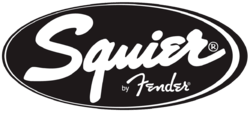 | |
| Subsidiary | |
| Industry | Musical instruments |
| Founded |
1890 in Battle Creek, Michigan, United States 1982 (Squier by Fender) |
| Founder | Victor Carroll Squier |
| Defunct | 1975-1982 |
| Headquarters | Scottsdale, Arizona, United States |
Area served | Worldwide |
| Products |
Electric guitars Bass guitars Acoustic guitars Guitar amplifiers |
| Parent | Fender |
| Website |
squierguitars |
The V.C. Squier Company manufactured strings for violins, banjos, and guitars. It was established in 1890 by Victor Carroll Squier in Battle Creek, Michigan. In 1965, the company was acquired by Fender. By 1975, Squier became defunct as a manufacturer and a brand name for strings, as Fender opted to market its strings under the Fender brand name.
In 1982, the Squier brand was reactivated by Fender to become its brand for lower priced versions of Fender guitars. Squier guitars have been manufactured in Japan, Korea, Mexico, India, Indonesia, China, and the United States.
History
V.C. Squier Company (1890-1975)
Jerome Bonaparte Squier, a young English immigrant who arrived in Battle Creek, Michigan, in the latter part of the 19th century, was a farmer and shoemaker who had learned the fine European art of violin making. He moved to Boston in 1881, where he built and repaired violins with his son, Victor Carroll Squier. To this day, their violins are noted for their exceptional varnishes, and they command high prices as fine examples of early U.S. instrument craftsmanship. Indeed, J.B. Squier ranks among the best-known U.S.-trained violin makers and is often referred to as "the American Stradivarius."
Victor returned to Battle Creek, where he opened his own shop in 1890. As his business grew, Squier moved the company to 429 Lake Ave. and eventually to 427 Capitol Ave, S.W.—the famous "fiddle factory" of Battle Creek. With a limited market for violins in Battle Creek, however, Squier astutely sought relationships with national music schools and famous violinists.
Up to 1900, the best violin strings were made in Europe. Victor Squier started making his own hand-wound violin strings, and the business grew so quickly that he and his employees improvised a dramatic production increase by converting a treadle sewing machine into a string winder capable of producing 1,000 uniformly high-quality strings per day. Squier violin strings, banjo strings and guitar strings became well known nationwide and were especially popular among students because of their reasonable price.
In the 1930s, Squier began making strings for the era's new electric instruments; the company also sold pianos, radios and phonograph records until divesting itself of all string-related products in 1961. Fender Electric Instruments entered the picture in the 1950s, when the V.C. Squier Company began supplying Southern California inventor and businessman Leo Fender with strings for his unusual new electric guitars. The V.C. Squier Company became an official original equipment manufacturer for Fender in 1963. Fender acquired the V.C. Squier Company in early 1965, shortly before Fender itself was acquired by CBS in May of the same year. By the mid-1970s, the Squier name was retired as the strings had taken the Fender name.[1]
Squier Guitars (1982-present)
Before the Fender Squier line of guitars was introduced in 1982, Fender was making lower priced guitars such as the Fender Lead series at its Fullerton, California plant. Until the introduction of the Fender Squier series, Fender had never produced lower priced guitars based on its main Stratocaster and Telecaster models and had always used different model designs for its lower priced guitars.
In the late 1970s and early 1980s Fender was facing competition from lower priced Japanese made guitars. The higher priced Fender guitars were made in the United States and could not compete with the lower prices of Japanese made Fender copies. In the early 1980s, Japanese labor and production costs were much lower than in America and to compete with the Japanese made guitars, Fender moved the lower priced Fender guitar production from America to Japan.
Fender was also losing sales in Japan to Japanese guitar brands such as Tōkai, Greco and Fernandes and the establishment of Fender Japan would benefit Fender sales in Japan, as well as overseas. Fender began negotiations with several Japanese musical instrument distributors and reached an agreement with Yamano Gakki and Kanda Shokai to establish Fender Japan. Yamano Gakki was known for once being part of Epiphone Japan. Kanda Shokai owned the Greco brand name and one of the conditions of the Fender Japan agreement was that Kanda Shokai cease production of its own Greco Fender copies. This arrangement benefited Fender because it removed the Greco Fender copies from the Japanese market, which were selling in Japan at much lower prices than the American made Fenders and it also benefited Kanda Shokai because Kanda Shokai could then distribute Japanese made Fender branded guitars in Japan. Further negotiations between Fender and Japanese guitar factories took place. Tokai was seriously considered to start building the first Japanese made Fenders, but after a breakdown in negotiations, FujiGen Gakki was chosen instead.[2]
The initial Squier models were launched on July/August 1982. Over time, the Squier series slowly evolved to include original model designs and production has moved from Japan to various other Asian countries such as Korea, China and Indonesia.
Instrument models
%2C_Jaguar_Bass.jpg)

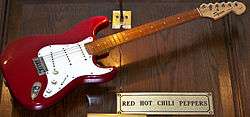

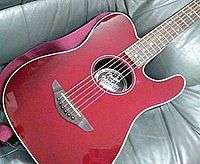
_by_Ludwig_D._Omen.jpg)
.jpg)
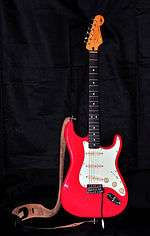
Acoustic guitars
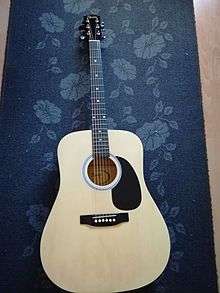
- MA-1
- SA Series
- Telecoustic
- Stratocoustic
Electric guitars
Original
- Squier '51
- Squier Telecaster Custom
- Squier Jagmaster
- Squier Venus (1997-1998)
- Squier Super-Sonic (1997-1998)
- Squier Stagemaster
- Squier Ryan Jarman Signature Guitar 'Mus-Uar' (2016)
Electric bass
- Precision Bass
- Jazz Bass
- Jaguar Bass
- Mustang Bass
- Musicmaster Bass
- Deluxe Active Jazz Bass
- Telecaster Bass
- Dimension Bass
- Bronco Bass
- Bass VI
- Mikey Way Signature Bass
- Gary Jarman Signature Bass
Amplifiers
- Squier 15
Instrument series
JV & SQ series
The first Fender Japan models introduced in May 1982 were the 1957 and 1962 series, which were Fender Stratocaster models ST'57-115, ST'57-85, ST'57-65, ST'62-115, ST'62-85, ST'62-65 and the Precision Bass models PB'57-95, PB'57-70, PB'62-98, PB'62-75. These models were Fender models and not Squier models. The Stratocasters had Fender USA pickups installed and were made for the Japanese market only and not for export.[3]
Fender soon added a less expensive export Squier series based on the Fender Japan 1957 and 1962 series in July/August 1982, which had a large Fender logo with a smaller Squier logo and had a zinc rather than a steel tremolo block and again the Stratocasters had Fender USA pickups installed. The Squier series were also made available for the Japanese market in October 1982, which incorporated small changes compared to the export Squier series. The large Fender logo of the export Squier series was soon changed to a large Squier logo.
The first Fender Japan guitars are known as the JV Fenders and JV Squiers, with JV standing for "Japanese Vintage" to reflect the guitars were made from the original blueprints of the vintage US guitars, were made by the FujiGen Gakki factory in Japan, using technical support from Fender. The SQ Squier series was introduced in late 1983 to early 1984. The SQ Squier series was based more on 1970s Fender models and also had USA made pickups installed.
Vista models
In 1996, Squier began to manufacture the Vista Series, which saw them introducing their own unique guitar designs independent from the Fender mother company for the first time. Made in the same factory as the Japanese Fenders of the era, they were known as high quality guitars. The series included the Supersonic guitar, the Venus guitar (co-designed by Courtney Love), the Jagmaster (a hybrid of the Fender Jaguar and Jazzmaster models), and a re-issue of the Musicmaster Bass. Later, in 97, a guitar version of the Musicmaster Bass was added, though it should be noted this was based on the bass design, and not the Fender Musicmaster guitar design of the 1960s. By 1998 the Vista Series was discontinued.
Pro Tone
Alongside the Vista series (which focused on contemporary designs) was the Pro Tone series, made in Korea at the Cort factory and focusing on classic models. Introduced in 1996 with a $500 RRP, the guitars were of higher quality than standard Squier guitars and featured ash bodies, satin finished necks and alnico pickups. The line consisted of 6 Stratocasters, a Fat Stratocaster (Humbucker at the bridge position), a Fat Telecaster (Humbucker at the neck position) and a Thinline Telecaster as well as a 4 string and 5 string Precision Bass. The series was discontinued under the Squier name in 1998 and moved to Mexico, as guitarists were unwilling to spend such high prices for Squier guitars. The series is still highly regarded and has held much of its value on the used market.
Affinity
The Squier lineup was augmented in 1996 with Affinity series guitars and basses. Entry-level Affinity Series instruments were straightforward, basic Stratocaster, Telecaster and Precision Bass guitars in black, red and white. The Affinity Series paved the way for the subsequent great success of Squier instrument/amp/accessory packages, such as the Strat Pak and Bass Pak, that provided aspiring musicians with everything they need to enter the world of amplified music in a single all-in-one purchase. These bundled Affinity guitars are manufactured in Indonesia (identified by skunk stripe on neck) whereas stand-alone Affinity are manufactured in China (identified by no skunk stripe on neck). The earliest guitars are not marked on the headstock as belonging to the Affinity series, but are easily identifiable by the decal stating "Strat" or "Tele" rather than the full name of the model.
Vintage Modified
The year 2004 saw the introduction of Squier's Vintage Modified line, a series of high-end instruments based around the concept of taking vintage designs and adding "hot rod" features such as hardware variations, gloss maple necks, new finishes and pickguards, and Duncan Designed pickups.[4] The VM line draws from a wide range of Fender instruments, and has resulted in a large variety of models with many different feature combinations.
Vintage Modified guitar models include Stratocasters, Telecasters, Jaguars, Jazzmasters and Mustangs. The bass lineup features Precision and Jazz basses (including fretless versions of both), Jaguars and Telecasters, with five-string and short-scale models featured in the range. In 2013 a Bass VI was added to the VM line. The majority of Vintage Modified instruments are available only in right-handed configurations.
Classic Vibe
In 2008, Squier released its Classic Vibe series, a series of electric guitars and basses mirroring classic Fender designs of the 1950s and '60s. Each roughly reflected the hardware, woods, color variations, finishes, body contours, and tonal characteristics of their respective era, although Squier state that the series was not created to be completely era correct, but rather impart the "vibe" (aura) of a classic Fender design.[5]
See also
References
- ↑ Fender Squier History Archived July 9, 2009, at the Wayback Machine.
- ↑ "Fender Japan History". Daeschler.com. Retrieved 2013-12-14.
- ↑ "guitar information and forum about JV - Japanese Vintage fender squier stratocaster guitars, squier telecaster and basses". 21frets.com. Retrieved 2013-12-14.
- ↑ "About Squier | Squier by Fender速". Fender.com. Retrieved 2013-12-14.
- ↑ Archived May 23, 2011, at the Wayback Machine.
External links
| Wikimedia Commons has media related to Squier. |